Commercial Law Case Study: Contracts and Consumer Law for Heidi's Shop
VerifiedAdded on 2022/12/26
|14
|3258
|1
Case Study
AI Summary
This case study analyzes a commercial law scenario centered around Heidi, who is starting her own coffee shop, "Roast the Day Away Pty Ltd." The assignment explores three main parts: Firstly, it examines an invitation to treat and misleading advertising concerning a coffee machine advertisement, determining whether Heidi has a claim. Secondly, it delves into the concept of consideration in relation to a potential coffee machine purchase from a seller, and whether a valid contract was formed. Thirdly, it addresses issues of intention to create legal relations concerning a second coffee machine sale, misrepresentation, and the potential for damages caused by a faulty machine purchased from a supplier. The analysis considers relevant legal principles, including the Australian Consumer Law (ACL), and applies them to the facts of the case to determine the rights and obligations of the parties involved.
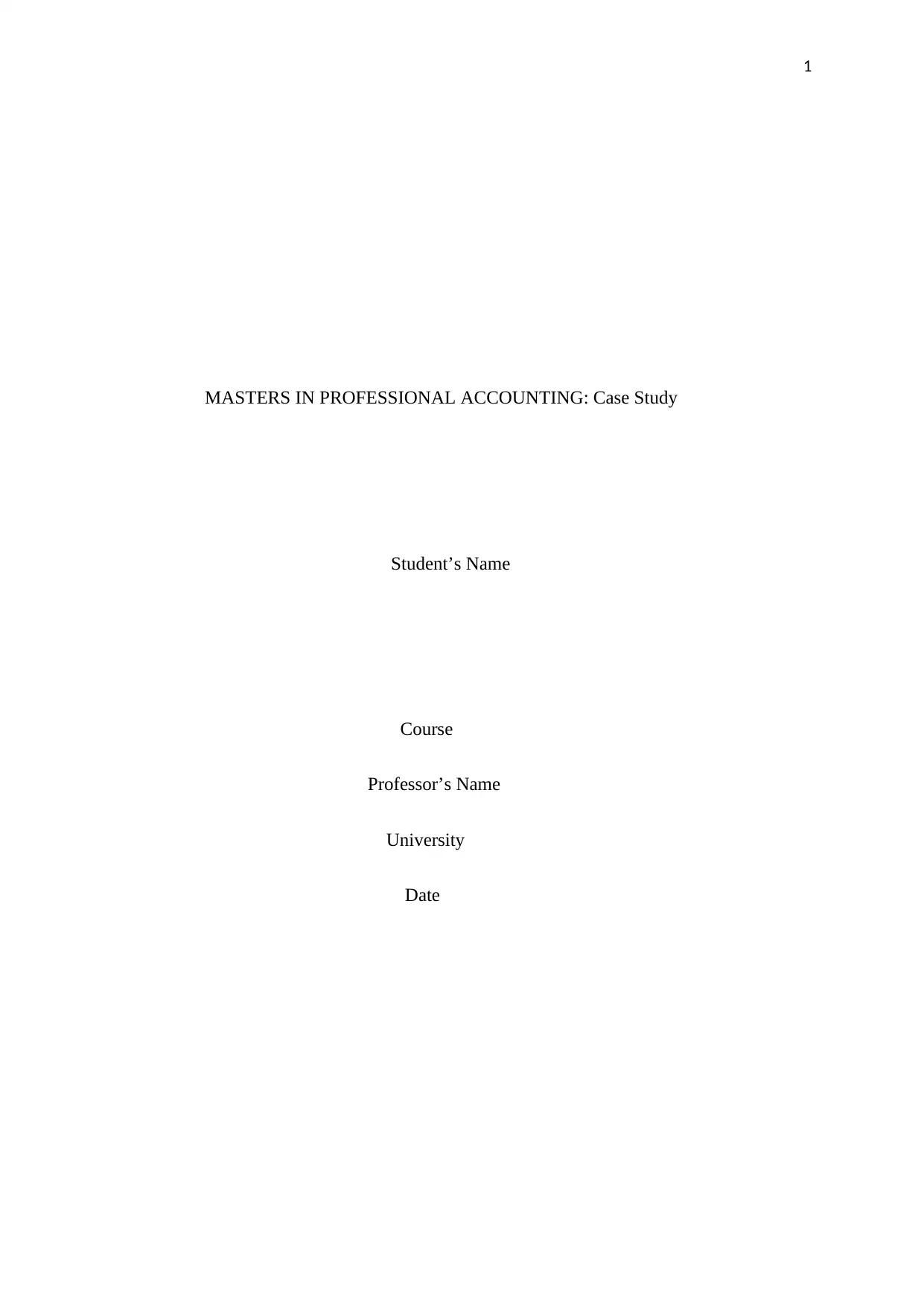
1
MASTERS IN PROFESSIONAL ACCOUNTING: Case Study
Student’s Name
Course
Professor’s Name
University
Date
MASTERS IN PROFESSIONAL ACCOUNTING: Case Study
Student’s Name
Course
Professor’s Name
University
Date
Paraphrase This Document
Need a fresh take? Get an instant paraphrase of this document with our AI Paraphraser
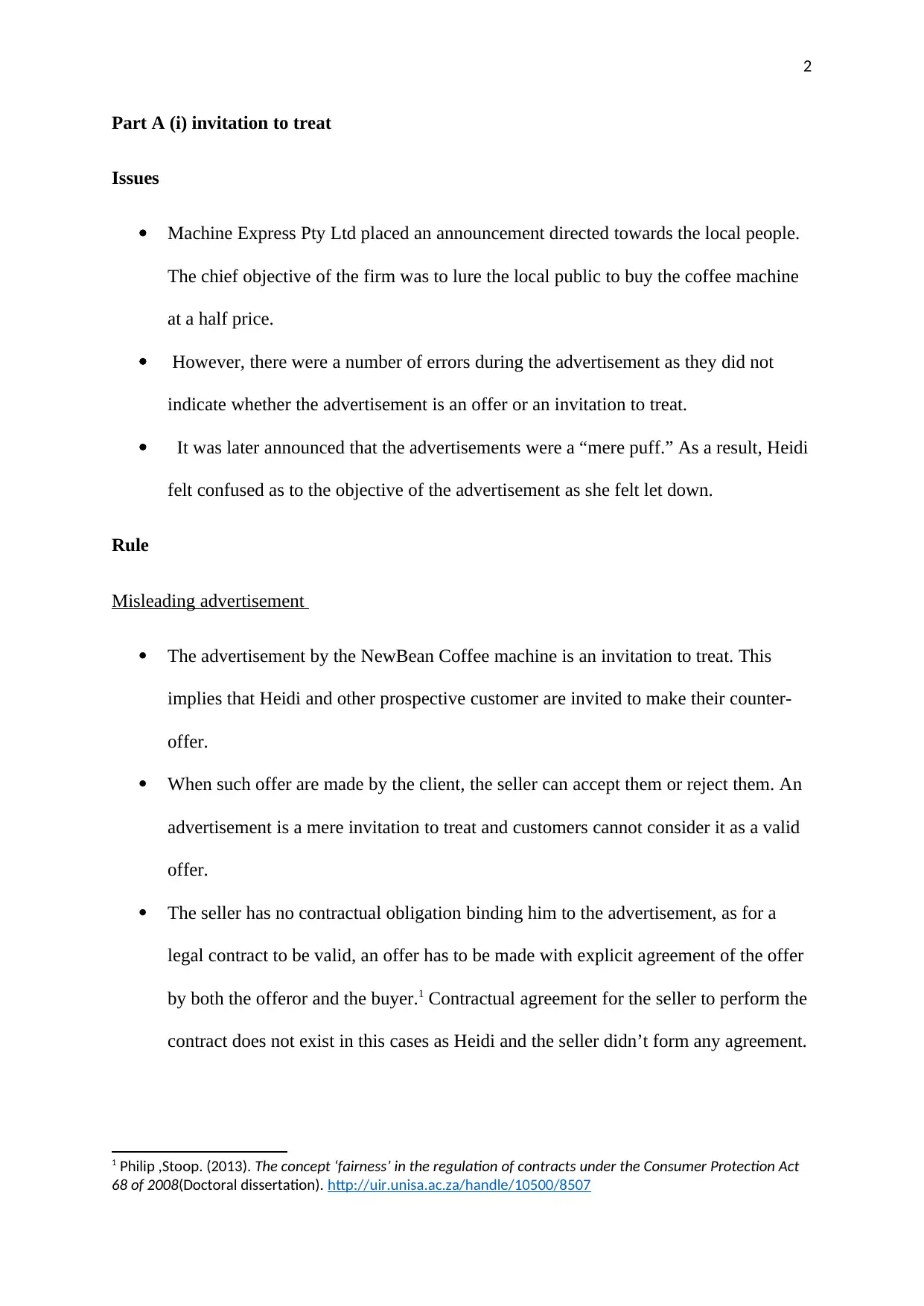
2
Part A (i) invitation to treat
Issues
Machine Express Pty Ltd placed an announcement directed towards the local people.
The chief objective of the firm was to lure the local public to buy the coffee machine
at a half price.
However, there were a number of errors during the advertisement as they did not
indicate whether the advertisement is an offer or an invitation to treat.
It was later announced that the advertisements were a “mere puff.” As a result, Heidi
felt confused as to the objective of the advertisement as she felt let down.
Rule
Misleading advertisement
The advertisement by the NewBean Coffee machine is an invitation to treat. This
implies that Heidi and other prospective customer are invited to make their counter-
offer.
When such offer are made by the client, the seller can accept them or reject them. An
advertisement is a mere invitation to treat and customers cannot consider it as a valid
offer.
The seller has no contractual obligation binding him to the advertisement, as for a
legal contract to be valid, an offer has to be made with explicit agreement of the offer
by both the offeror and the buyer.1 Contractual agreement for the seller to perform the
contract does not exist in this cases as Heidi and the seller didn’t form any agreement.
1 Philip ,Stoop. (2013). The concept ‘fairness’ in the regulation of contracts under the Consumer Protection Act
68 of 2008(Doctoral dissertation). http://uir.unisa.ac.za/handle/10500/8507
Part A (i) invitation to treat
Issues
Machine Express Pty Ltd placed an announcement directed towards the local people.
The chief objective of the firm was to lure the local public to buy the coffee machine
at a half price.
However, there were a number of errors during the advertisement as they did not
indicate whether the advertisement is an offer or an invitation to treat.
It was later announced that the advertisements were a “mere puff.” As a result, Heidi
felt confused as to the objective of the advertisement as she felt let down.
Rule
Misleading advertisement
The advertisement by the NewBean Coffee machine is an invitation to treat. This
implies that Heidi and other prospective customer are invited to make their counter-
offer.
When such offer are made by the client, the seller can accept them or reject them. An
advertisement is a mere invitation to treat and customers cannot consider it as a valid
offer.
The seller has no contractual obligation binding him to the advertisement, as for a
legal contract to be valid, an offer has to be made with explicit agreement of the offer
by both the offeror and the buyer.1 Contractual agreement for the seller to perform the
contract does not exist in this cases as Heidi and the seller didn’t form any agreement.
1 Philip ,Stoop. (2013). The concept ‘fairness’ in the regulation of contracts under the Consumer Protection Act
68 of 2008(Doctoral dissertation). http://uir.unisa.ac.za/handle/10500/8507
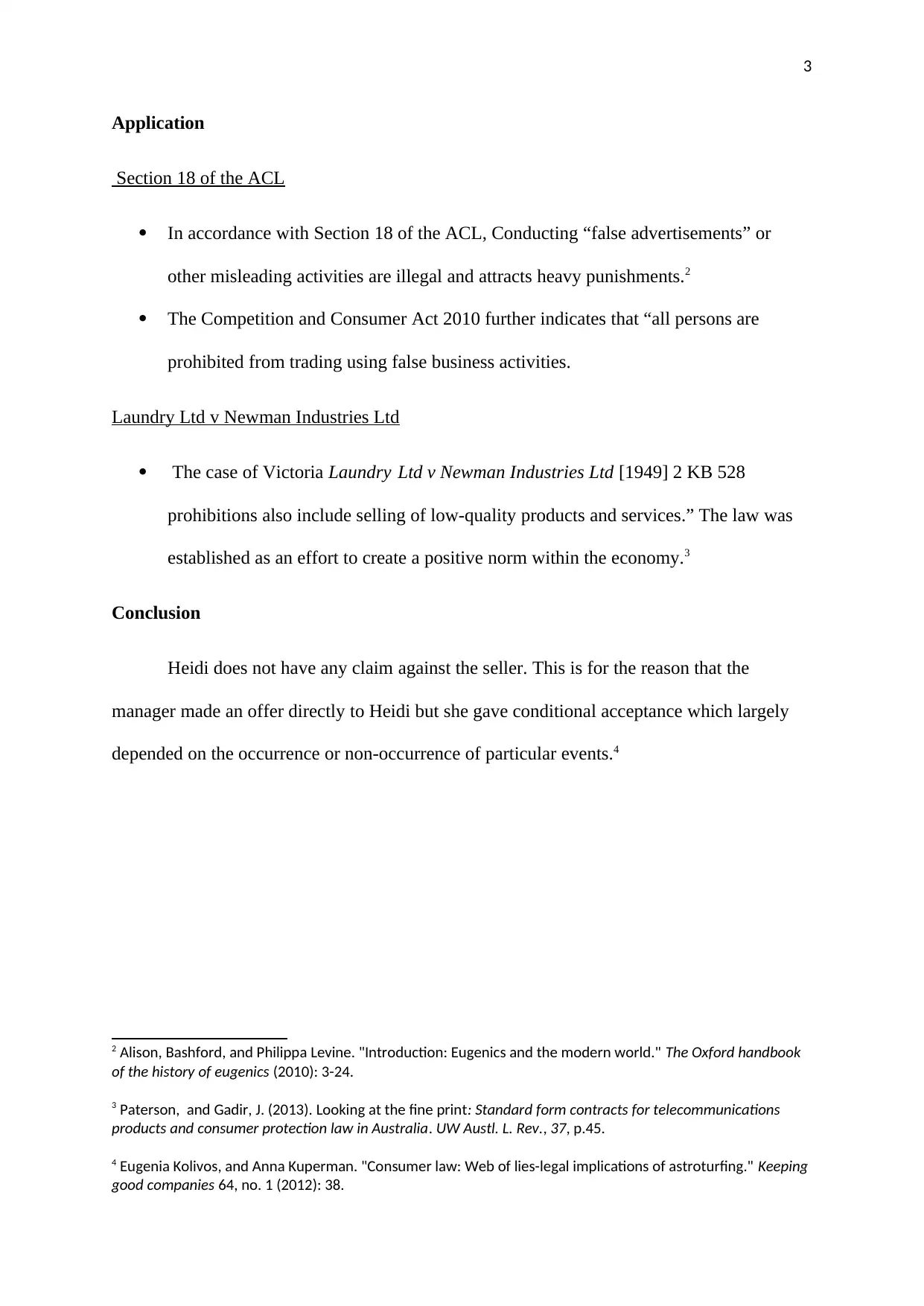
3
Application
Section 18 of the ACL
In accordance with Section 18 of the ACL, Conducting “false advertisements” or
other misleading activities are illegal and attracts heavy punishments.2
The Competition and Consumer Act 2010 further indicates that “all persons are
prohibited from trading using false business activities.
Laundry Ltd v Newman Industries Ltd
The case of Victoria Laundry Ltd v Newman Industries Ltd [1949] 2 KB 528
prohibitions also include selling of low-quality products and services.” The law was
established as an effort to create a positive norm within the economy.3
Conclusion
Heidi does not have any claim against the seller. This is for the reason that the
manager made an offer directly to Heidi but she gave conditional acceptance which largely
depended on the occurrence or non-occurrence of particular events.4
2 Alison, Bashford, and Philippa Levine. "Introduction: Eugenics and the modern world." The Oxford handbook
of the history of eugenics (2010): 3-24.
3 Paterson, and Gadir, J. (2013). Looking at the fine print: Standard form contracts for telecommunications
products and consumer protection law in Australia. UW Austl. L. Rev., 37, p.45.
4 Eugenia Kolivos, and Anna Kuperman. "Consumer law: Web of lies-legal implications of astroturfing." Keeping
good companies 64, no. 1 (2012): 38.
Application
Section 18 of the ACL
In accordance with Section 18 of the ACL, Conducting “false advertisements” or
other misleading activities are illegal and attracts heavy punishments.2
The Competition and Consumer Act 2010 further indicates that “all persons are
prohibited from trading using false business activities.
Laundry Ltd v Newman Industries Ltd
The case of Victoria Laundry Ltd v Newman Industries Ltd [1949] 2 KB 528
prohibitions also include selling of low-quality products and services.” The law was
established as an effort to create a positive norm within the economy.3
Conclusion
Heidi does not have any claim against the seller. This is for the reason that the
manager made an offer directly to Heidi but she gave conditional acceptance which largely
depended on the occurrence or non-occurrence of particular events.4
2 Alison, Bashford, and Philippa Levine. "Introduction: Eugenics and the modern world." The Oxford handbook
of the history of eugenics (2010): 3-24.
3 Paterson, and Gadir, J. (2013). Looking at the fine print: Standard form contracts for telecommunications
products and consumer protection law in Australia. UW Austl. L. Rev., 37, p.45.
4 Eugenia Kolivos, and Anna Kuperman. "Consumer law: Web of lies-legal implications of astroturfing." Keeping
good companies 64, no. 1 (2012): 38.
⊘ This is a preview!⊘
Do you want full access?
Subscribe today to unlock all pages.

Trusted by 1+ million students worldwide
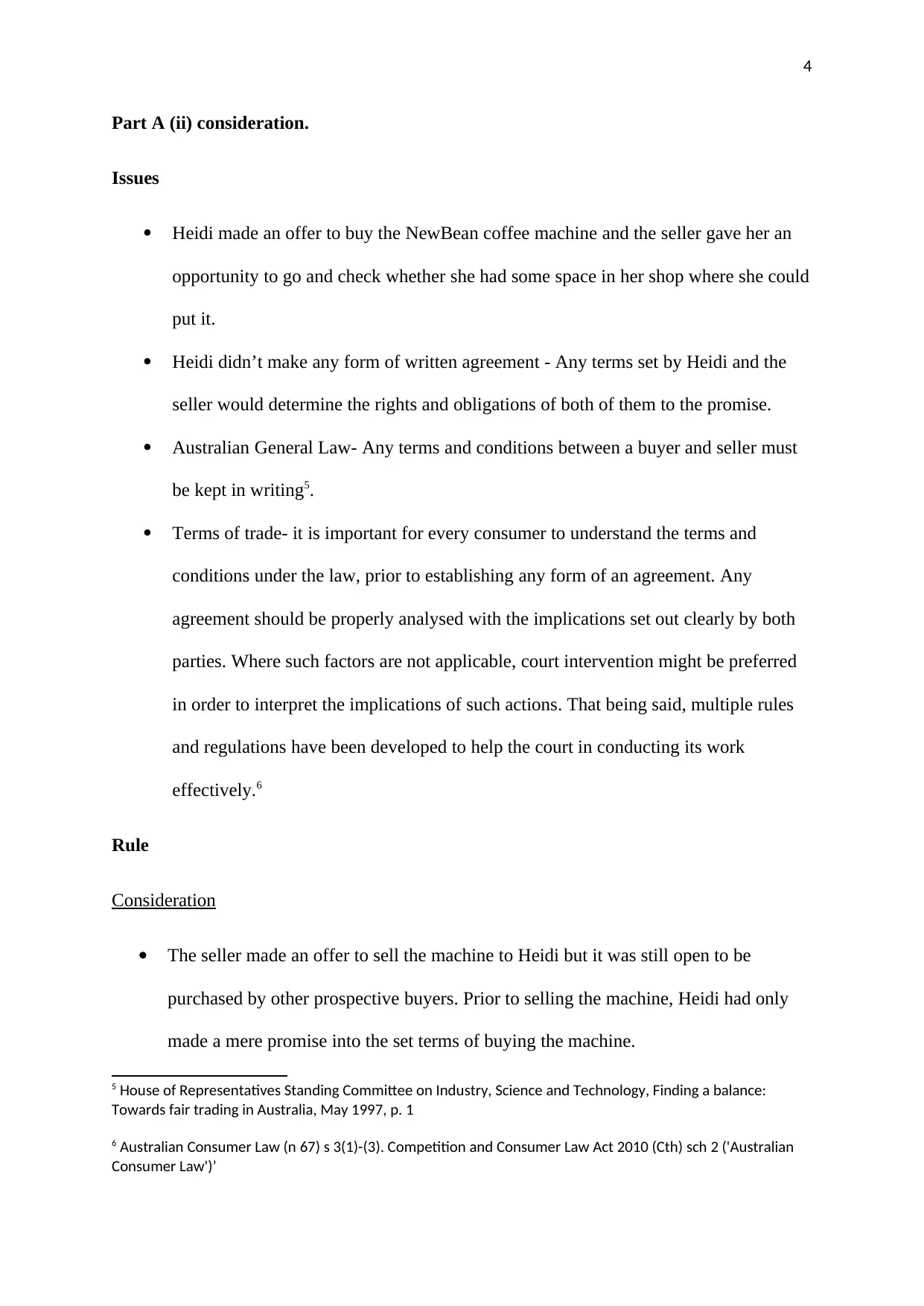
4
Part A (ii) consideration.
Issues
Heidi made an offer to buy the NewBean coffee machine and the seller gave her an
opportunity to go and check whether she had some space in her shop where she could
put it.
Heidi didn’t make any form of written agreement - Any terms set by Heidi and the
seller would determine the rights and obligations of both of them to the promise.
Australian General Law- Any terms and conditions between a buyer and seller must
be kept in writing5.
Terms of trade- it is important for every consumer to understand the terms and
conditions under the law, prior to establishing any form of an agreement. Any
agreement should be properly analysed with the implications set out clearly by both
parties. Where such factors are not applicable, court intervention might be preferred
in order to interpret the implications of such actions. That being said, multiple rules
and regulations have been developed to help the court in conducting its work
effectively.6
Rule
Consideration
The seller made an offer to sell the machine to Heidi but it was still open to be
purchased by other prospective buyers. Prior to selling the machine, Heidi had only
made a mere promise into the set terms of buying the machine.
5 House of Representatives Standing Committee on Industry, Science and Technology, Finding a balance:
Towards fair trading in Australia, May 1997, p. 1
6 Australian Consumer Law (n 67) s 3(1)-(3). Competition and Consumer Law Act 2010 (Cth) sch 2 ('Australian
Consumer Law')’
Part A (ii) consideration.
Issues
Heidi made an offer to buy the NewBean coffee machine and the seller gave her an
opportunity to go and check whether she had some space in her shop where she could
put it.
Heidi didn’t make any form of written agreement - Any terms set by Heidi and the
seller would determine the rights and obligations of both of them to the promise.
Australian General Law- Any terms and conditions between a buyer and seller must
be kept in writing5.
Terms of trade- it is important for every consumer to understand the terms and
conditions under the law, prior to establishing any form of an agreement. Any
agreement should be properly analysed with the implications set out clearly by both
parties. Where such factors are not applicable, court intervention might be preferred
in order to interpret the implications of such actions. That being said, multiple rules
and regulations have been developed to help the court in conducting its work
effectively.6
Rule
Consideration
The seller made an offer to sell the machine to Heidi but it was still open to be
purchased by other prospective buyers. Prior to selling the machine, Heidi had only
made a mere promise into the set terms of buying the machine.
5 House of Representatives Standing Committee on Industry, Science and Technology, Finding a balance:
Towards fair trading in Australia, May 1997, p. 1
6 Australian Consumer Law (n 67) s 3(1)-(3). Competition and Consumer Law Act 2010 (Cth) sch 2 ('Australian
Consumer Law')’
Paraphrase This Document
Need a fresh take? Get an instant paraphrase of this document with our AI Paraphraser
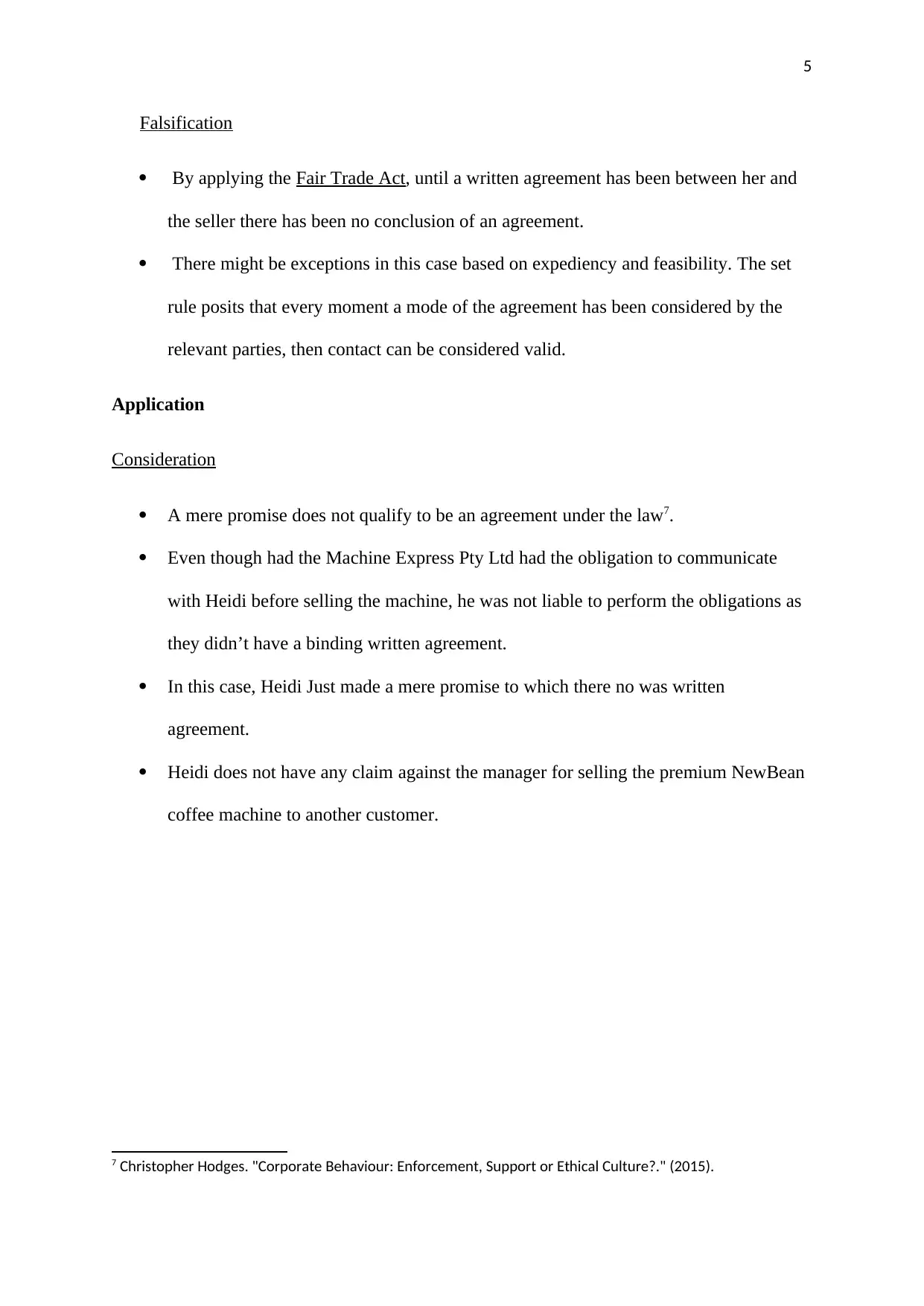
5
Falsification
By applying the Fair Trade Act, until a written agreement has been between her and
the seller there has been no conclusion of an agreement.
There might be exceptions in this case based on expediency and feasibility. The set
rule posits that every moment a mode of the agreement has been considered by the
relevant parties, then contact can be considered valid.
Application
Consideration
A mere promise does not qualify to be an agreement under the law7.
Even though had the Machine Express Pty Ltd had the obligation to communicate
with Heidi before selling the machine, he was not liable to perform the obligations as
they didn’t have a binding written agreement.
In this case, Heidi Just made a mere promise to which there no was written
agreement.
Heidi does not have any claim against the manager for selling the premium NewBean
coffee machine to another customer.
7 Christopher Hodges. "Corporate Behaviour: Enforcement, Support or Ethical Culture?." (2015).
Falsification
By applying the Fair Trade Act, until a written agreement has been between her and
the seller there has been no conclusion of an agreement.
There might be exceptions in this case based on expediency and feasibility. The set
rule posits that every moment a mode of the agreement has been considered by the
relevant parties, then contact can be considered valid.
Application
Consideration
A mere promise does not qualify to be an agreement under the law7.
Even though had the Machine Express Pty Ltd had the obligation to communicate
with Heidi before selling the machine, he was not liable to perform the obligations as
they didn’t have a binding written agreement.
In this case, Heidi Just made a mere promise to which there no was written
agreement.
Heidi does not have any claim against the manager for selling the premium NewBean
coffee machine to another customer.
7 Christopher Hodges. "Corporate Behaviour: Enforcement, Support or Ethical Culture?." (2015).
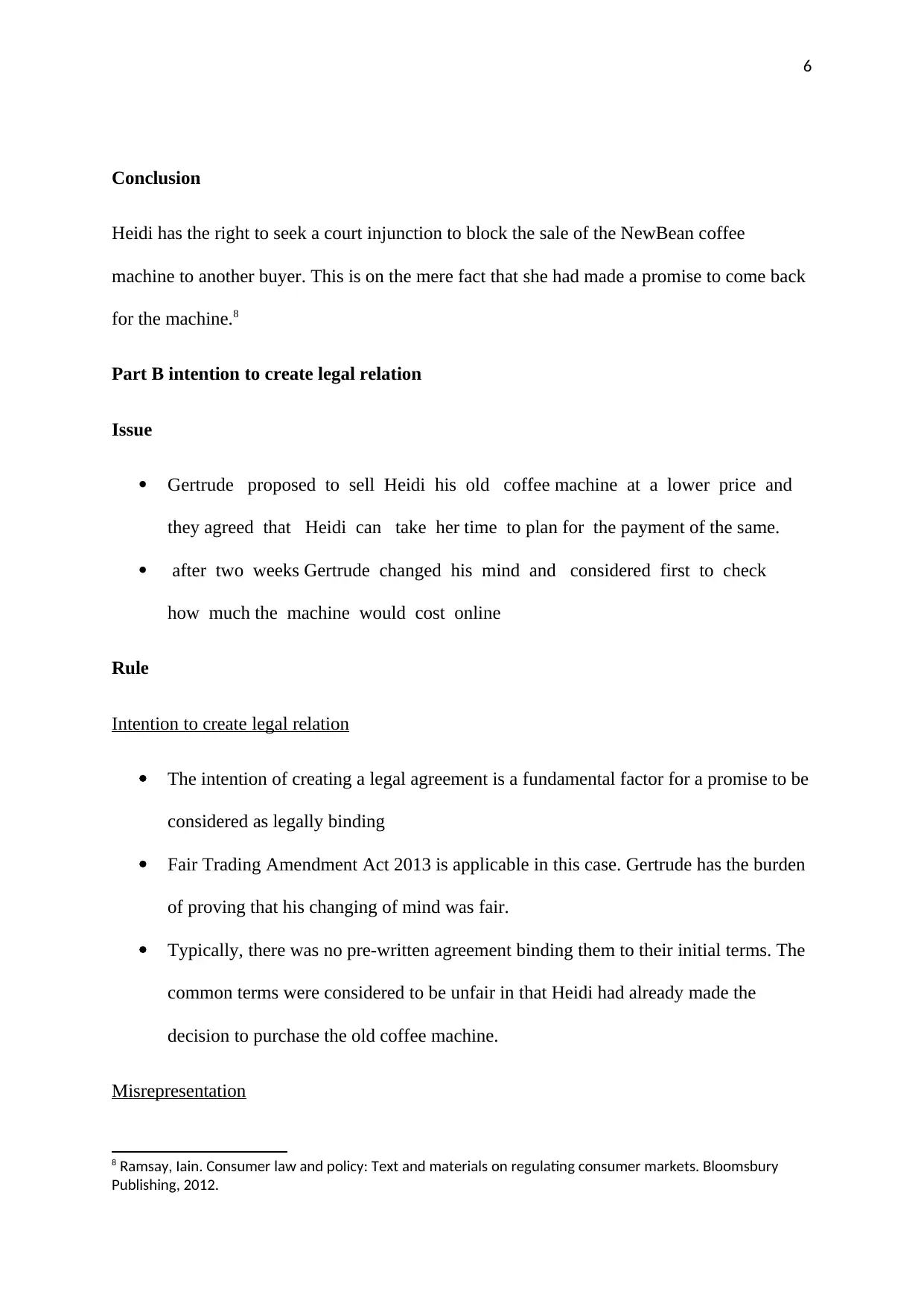
6
Conclusion
Heidi has the right to seek a court injunction to block the sale of the NewBean coffee
machine to another buyer. This is on the mere fact that she had made a promise to come back
for the machine.8
Part B intention to create legal relation
Issue
Gertrude proposed to sell Heidi his old coffee machine at a lower price and
they agreed that Heidi can take her time to plan for the payment of the same.
after two weeks Gertrude changed his mind and considered first to check
how much the machine would cost online
Rule
Intention to create legal relation
The intention of creating a legal agreement is a fundamental factor for a promise to be
considered as legally binding
Fair Trading Amendment Act 2013 is applicable in this case. Gertrude has the burden
of proving that his changing of mind was fair.
Typically, there was no pre-written agreement binding them to their initial terms. The
common terms were considered to be unfair in that Heidi had already made the
decision to purchase the old coffee machine.
Misrepresentation
8 Ramsay, Iain. Consumer law and policy: Text and materials on regulating consumer markets. Bloomsbury
Publishing, 2012.
Conclusion
Heidi has the right to seek a court injunction to block the sale of the NewBean coffee
machine to another buyer. This is on the mere fact that she had made a promise to come back
for the machine.8
Part B intention to create legal relation
Issue
Gertrude proposed to sell Heidi his old coffee machine at a lower price and
they agreed that Heidi can take her time to plan for the payment of the same.
after two weeks Gertrude changed his mind and considered first to check
how much the machine would cost online
Rule
Intention to create legal relation
The intention of creating a legal agreement is a fundamental factor for a promise to be
considered as legally binding
Fair Trading Amendment Act 2013 is applicable in this case. Gertrude has the burden
of proving that his changing of mind was fair.
Typically, there was no pre-written agreement binding them to their initial terms. The
common terms were considered to be unfair in that Heidi had already made the
decision to purchase the old coffee machine.
Misrepresentation
8 Ramsay, Iain. Consumer law and policy: Text and materials on regulating consumer markets. Bloomsbury
Publishing, 2012.
⊘ This is a preview!⊘
Do you want full access?
Subscribe today to unlock all pages.

Trusted by 1+ million students worldwide
1 out of 14
Related Documents
Your All-in-One AI-Powered Toolkit for Academic Success.
+13062052269
info@desklib.com
Available 24*7 on WhatsApp / Email
![[object Object]](/_next/static/media/star-bottom.7253800d.svg)
Unlock your academic potential
Copyright © 2020–2025 A2Z Services. All Rights Reserved. Developed and managed by ZUCOL.





